[English] 日本語
 Yorodumi
Yorodumi- PDB-6c8g: Crystal structure of Transient Receptor Potential (TRP) channel T... -
+ Open data
Open data
- Basic information
Basic information
| Entry | Database: PDB / ID: 6c8g | ||||||
|---|---|---|---|---|---|---|---|
| Title | Crystal structure of Transient Receptor Potential (TRP) channel TRPV4 in the presence of barium | ||||||
 Components Components | Transient receptor potential cation channel, subfamily V, member 4 | ||||||
 Keywords Keywords | TRANSPORT PROTEIN / ion channal | ||||||
| Function / homology |  Function and homology information Function and homology informationTRP channels / plasma membrane => GO:0005886 / osmosensory signaling pathway / calcium ion import across plasma membrane / monoatomic ion channel activity / actin filament organization / calcium channel activity / cilium Similarity search - Function | ||||||
| Biological species | |||||||
| Method |  X-RAY DIFFRACTION / X-RAY DIFFRACTION /  SYNCHROTRON / SYNCHROTRON /  MOLECULAR REPLACEMENT / Resolution: 6.31 Å MOLECULAR REPLACEMENT / Resolution: 6.31 Å | ||||||
 Authors Authors | Deng, Z. / Paknejad, N. / Maksaev, G. / Sala-Rabanal, M. / Nichols, C.G. / Hite, R.K. / Yuan, P. | ||||||
 Citation Citation |  Journal: Nat Struct Mol Biol / Year: 2018 Journal: Nat Struct Mol Biol / Year: 2018Title: Cryo-EM and X-ray structures of TRPV4 reveal insight into ion permeation and gating mechanisms. Authors: Zengqin Deng / Navid Paknejad / Grigory Maksaev / Monica Sala-Rabanal / Colin G Nichols / Richard K Hite / Peng Yuan /  Abstract: The transient receptor potential (TRP) channel TRPV4 participates in multiple biological processes, and numerous TRPV4 mutations underlie several distinct and devastating diseases. Here we present ...The transient receptor potential (TRP) channel TRPV4 participates in multiple biological processes, and numerous TRPV4 mutations underlie several distinct and devastating diseases. Here we present the cryo-EM structure of Xenopus tropicalis TRPV4 at 3.8-Å resolution. The ion-conduction pore contains an intracellular gate formed by the inner helices, but lacks any extracellular gate in the selectivity filter, as observed in other TRPV channels. Anomalous X-ray diffraction analyses identify a single ion-binding site in the selectivity filter, thus explaining TRPV4 nonselectivity. Structural comparisons with other TRP channels and distantly related voltage-gated cation channels reveal an unprecedented, unique packing interface between the voltage-sensor-like domain and the pore domain, suggesting distinct gating mechanisms. Moreover, our structure begins to provide mechanistic insights to the large set of pathogenic mutations, offering potential opportunities for drug development. | ||||||
| History |
|
- Structure visualization
Structure visualization
| Structure viewer | Molecule:  Molmil Molmil Jmol/JSmol Jmol/JSmol |
|---|
- Downloads & links
Downloads & links
- Download
Download
| PDBx/mmCIF format |  6c8g.cif.gz 6c8g.cif.gz | 121.5 KB | Display |  PDBx/mmCIF format PDBx/mmCIF format |
|---|---|---|---|---|
| PDB format |  pdb6c8g.ent.gz pdb6c8g.ent.gz | 88.2 KB | Display |  PDB format PDB format |
| PDBx/mmJSON format |  6c8g.json.gz 6c8g.json.gz | Tree view |  PDBx/mmJSON format PDBx/mmJSON format | |
| Others |  Other downloads Other downloads |
-Validation report
| Summary document |  6c8g_validation.pdf.gz 6c8g_validation.pdf.gz | 426 KB | Display |  wwPDB validaton report wwPDB validaton report |
|---|---|---|---|---|
| Full document |  6c8g_full_validation.pdf.gz 6c8g_full_validation.pdf.gz | 428.7 KB | Display | |
| Data in XML |  6c8g_validation.xml.gz 6c8g_validation.xml.gz | 19.4 KB | Display | |
| Data in CIF |  6c8g_validation.cif.gz 6c8g_validation.cif.gz | 27.2 KB | Display | |
| Arichive directory |  https://data.pdbj.org/pub/pdb/validation_reports/c8/6c8g https://data.pdbj.org/pub/pdb/validation_reports/c8/6c8g ftp://data.pdbj.org/pub/pdb/validation_reports/c8/6c8g ftp://data.pdbj.org/pub/pdb/validation_reports/c8/6c8g | HTTPS FTP |
-Related structure data
| Related structure data |  7075C 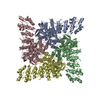 6bbjSC  6c8fC  6c8hC S: Starting model for refinement C: citing same article ( |
|---|---|
| Similar structure data |
- Links
Links
- Assembly
Assembly
| Deposited unit | 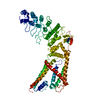
| ||||||||
|---|---|---|---|---|---|---|---|---|---|
| 1 | 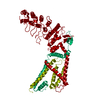
| ||||||||
| Unit cell |
| ||||||||
| Components on special symmetry positions |
|
- Components
Components
| #1: Protein | Mass: 77068.680 Da / Num. of mol.: 1 / Fragment: residues 133-797 / Mutation: N516Q Source method: isolated from a genetically manipulated source Source: (gene. exp.) Gene: trpv4 / Production host:  Komagataella pastoris (fungus) / References: UniProt: F7BWY7 Komagataella pastoris (fungus) / References: UniProt: F7BWY7 |
|---|---|
| #2: Chemical | ChemComp-BA / |
-Experimental details
-Experiment
| Experiment | Method:  X-RAY DIFFRACTION / Number of used crystals: 1 X-RAY DIFFRACTION / Number of used crystals: 1 |
|---|
- Sample preparation
Sample preparation
| Crystal | Density Matthews: 4.62 Å3/Da / Density % sol: 73.4 % |
|---|---|
| Crystal grow | Temperature: 277 K / Method: vapor diffusion, hanging drop Details: 50 mM MES pH6.0, 100 mM NaCl, 5.5% PEG4000, and 10% glycerol |
-Data collection
| Diffraction | Mean temperature: 100 K |
|---|---|
| Diffraction source | Source:  SYNCHROTRON / Site: SYNCHROTRON / Site:  APS APS  / Beamline: 24-ID-C / Wavelength: 1.7106 Å / Beamline: 24-ID-C / Wavelength: 1.7106 Å |
| Detector | Type: DECTRIS PILATUS 6M-F / Detector: PIXEL / Date: Jul 15, 2017 |
| Radiation | Protocol: SINGLE WAVELENGTH / Monochromatic (M) / Laue (L): M / Scattering type: x-ray |
| Radiation wavelength | Wavelength: 1.7106 Å / Relative weight: 1 |
| Reflection | Resolution: 6.3→20 Å / Num. obs: 3348 / % possible obs: 99.8 % / Redundancy: 9.9 % / Rpim(I) all: 0.03 / Net I/σ(I): 30.7 |
| Reflection shell | Resolution: 6.3→6.52 Å / Num. unique obs: 320 / Rpim(I) all: 0.427 |
- Processing
Processing
| Software |
| ||||||||||||||||||||
|---|---|---|---|---|---|---|---|---|---|---|---|---|---|---|---|---|---|---|---|---|---|
| Refinement | Method to determine structure:  MOLECULAR REPLACEMENT MOLECULAR REPLACEMENTStarting model: 6BBJ Resolution: 6.31→20 Å / Cor.coef. Fo:Fc: 0.806 / Cor.coef. Fo:Fc free: 0.845 / SU B: 0.028 / SU ML: 0 / Cross valid method: THROUGHOUT / ESU R: 3.167 / ESU R Free: 3.13 / Stereochemistry target values: MAXIMUM LIKELIHOOD / Details: HYDROGENS HAVE BEEN ADDED IN THE RIDING POSITIONS
| ||||||||||||||||||||
| Solvent computation | Ion probe radii: 0.8 Å / Shrinkage radii: 0.8 Å / VDW probe radii: 1.2 Å / Solvent model: MASK | ||||||||||||||||||||
| Displacement parameters | Biso mean: 100.004 Å2
| ||||||||||||||||||||
| Refinement step | Cycle: 1 / Resolution: 6.31→20 Å
| ||||||||||||||||||||
| LS refinement shell | Resolution: 6.312→6.459 Å / Total num. of bins used: 20
|
 Movie
Movie Controller
Controller






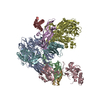
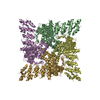
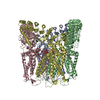
 PDBj
PDBj


